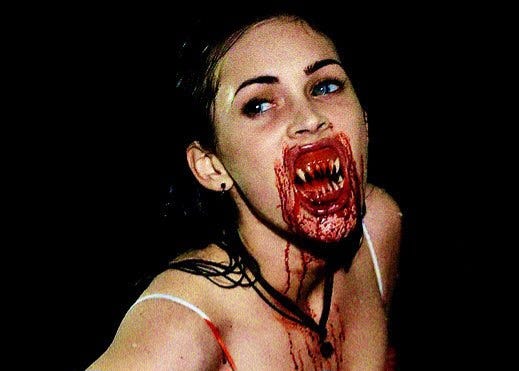Jennifer's Body and the monstrous feminine
Whenever I mention Jennifer’s Body (2009) as one of my favorite movies of all time, I usually receive mixed reactions. Most recently I heard it was “a cult classic, a thing that has been reevaluated recently.” I can’t necessarily disagree because it is and it has; the only thing I would want more than to see Karyn Kusama, Megan Fox and Diablo Cody get their due flowers for making the horror-comedy movie of a generation is that it would’ve happened much sooner. What irks me is that it had to be reevaluated at all. The terrible reviews the movie received were mostly due to the atrocious marketing choices. They chose the target were college boys, of all demographics to appeal to. Apart from the surface level observation of featuring Megan Fox, who was at the top of her Transformers (2007) fame, I don’t know what gave the 20th Century Fox marketing team any indication that frat boys would be heavily interested in a movie about a quasi-succubus that’s in a terribly entangled homoerotic friendship.
Back then, meaning not even 10 years ago, most movies except for romcoms were made to appeal to Dudes™. So, from a producing standpoint, if you wanted movies that weren’t from existing IP to rake in any box office cash, they had to cast a bonafide sex symbol somewhere in there. Pretty much never really as the lead role, they didn’t get that much attention, it was usually as the love interest that is the perfect combination of manic pixie dream girl and deus ex machina. Preferably with a gratuitous scene where you see them in their beautifully delicate but incredibly uncomfortable underwear, à la that scene from Scary Movie (2000) where Carmen Electra runs through sprinklers in her white lingerie and gets stabbed in the breast implant while trying to escape a serial killer.
That one is a well done spoof and gets played for laughs, but it works because that really was the role most women had, particularly in slasher horror movies. So imagine everyone’s surprise, mine included on my first of seven watches so far, when the titular Jennifer, the not quite virgin that gets sacrificed to the devil by a fame seeking boy band, not only returns but does so as a murderous half she-demon and begins painting the town arterial-blood red; leaving victims that “looked like lasagna with teeth.” She’s still Jennifer Check, meaning smooth talking and gorgeous; all pink, plump lips, luscious, glossy hair, perfect curves in almost offensively low-rise jeans. However, now she’s an actual man eater and in the same breath that she’ll use to ask for a date she’ll grow fangs and feast on the local emo kid’s neck. On top of that, most of the focus of the third act is that she has a falling out with her childhood best friend that she’s kind of homoerotically obsessed with. I’m not a teenage boy, thank God, but I imagine this subversion of pretty much every popular and expected trope was bound to unsettle men and their fragile, heart-of-glass ego.
Watching this movie was what I would consider my, and I imagine many people’s, first foray into the concept of the monstrous feminine. Barbara Creed coined the term in the collection of essays The Monstrous-Feminine: Film, Feminism, Psychoanalysis (1993) where she studied how often women tend to be the victims in films and in the cases they aren’t, how female monsters are often depicted as monstrous for reasons relating to their bodies, gender and sexuality. In particular, Creed argued that women are either constructed as virgins or whores. This is also present in Jennifer’s Body. The band needs a virgin for the sacrifice and while Jennifer very much isn’t, they make an assessment that she is someone who “loves to show it off but does not give it up.” In this movie, Jennifer’s monstrosity is a result of this violence, which is also arguably a metaphor for sexual assault, caused by presumptions thrust upon her.
Creed also covers how prominently feared or demonized coming of age women are, this usually symbolized through getting their first period accompanied by some horrifying consequence. Think Carrie (1976) and how that traumatic locker room “Plug it up!” experience resulted in a massacre. There’s a lot more to her theory that bleeds into some Freud-heavy, female castration, bio essentialist concepts; however, the idea that the monstrous feminine deconstructs typical gender norms, the concept of womanhood and how women are presented in film is a very interesting lens from which to observe the horror genre but specifically everyday life, too.
Truth is, women should scare you, they should terrify you. They’re not merely wallflowers, dolls to dress up or brides to marry off for a dowry. Girls can be ruthless, harsh, frightening creatures from the moment they get to first grade. They have rage, they destroy, they wound. Even if they don’t turn into a werewolf with their first period like Ginger in Ginger Snaps (2000) or if their pussy doesn’t grow teeth to fend off aggressors like Dawn’s in Teeth (2007) or even if they’re not eating boys for sustenance like Jennifer, a woman's violence is reactionary to her surrounding and there are few things more vicious and cruel than being sculpted by an environment set up to undermine and repress you from the moment you start to show any sense of self.
After all, we're forced to contend with the monstrousness of having our identity and worth forcibly thrust upon us as a prerequisite since we’re in diapers. If you’ve been fed that narrative long enough to grow as weary and tired and rageful as these characters, that’s when femininity as a concept comes undone. It tears itself apart and warps, bends and deforms until there’s nothing more feminine than breaking through that mold and coming out the other side as monsters, with scraped knuckles and torn nails, snarling and bloodied.





